ICSE Biology Previous year Question Paper 2019 Solved for Class 10
ICSE 2019 Biology Board Question Paper Solved
General Instructions:
- Answers to this Paper must be written on the paper provided separately.
- You will not be allowed to write during the first 15 minutes.
- This time is to be spent in reading the Question Paper.
- The time given at the head of this paper is the time allowed for writing the answers.
- Attempt all questions from Section I and any four questions from Section II.
- The intended marks for questions or parts of questions are given in brackets [ ].
Section -1 (40 Marks)
(Attempt All questions from this section)
Question 1.
(a) Name the following : [5]
(i) The layer of the eyeball that provide nourishment to the eye.
(ii) One gaseous compound which depletes the ozone layer.
(iii) The structure which connects the placenta and the foetus.
(iv) A pair of corresponding chromosomes of the same shape and size and derived one from each parent.
(v) The compound formed when haemoglobin combines with carbon dioxide in blood.
Answer:
(i) Choroid
(ii) Chlorofluorocarbon
(iii) Umbilical Cord
(iv) Homologous Chromosome
(v) Carbaminohaemoglobin
(b) Correct and rewrite the statement by changing the biological term that is underlined for each statement: [5]
(i) The theory of Inheritance of Acquired Characters was proposed by Watson and Crick.
(ii The protective sac which develops around the developing embryo is called the Pericardium.
(iii) Maintaining balance of the body and coordinating muscular activities is carried by the cerebrum.
(iv) The kidney is composed of number of neurons.
(v) The part of the eye which can be donated from a clinically dead person is the Retina.
Answer:
(i) The theory of inheritance of Acquired Characters was proposed by Jean Baptiste de Lamark.
(ii) The protective sac which develops around the developing embryo is called amnion.
(iii) Maintaining balance of the body and coordinating muscular activities is carried out by the Cerebellum.
(iv) The kidney is composed of number of nephrons.
(v) The part of the eye which can be donated from a clinically dead person is cornea.
(c) Give suitable biological reasons for the following statements : [5]
(i) The birth rate in India is very high.
(ii) Carbon monoxide is dangerous when inhaled.
(in) Root hairs become flaccid and droop when excess fertilizers are added to the moist soil around them.
(iv) Acid rain is harmful to the environment.
(v) All life on Earth is supported by Photosynthesis.
Answer:
(i) Due to better medical care there is a fall in death rate both for infants and the old. As long as birth rate exceeds death rate population grows rapidly.
(ii) Haemoglobin has very strong affinity for carbon monoxide, forming a stable compound carboxyhaemoglobin. This cuts down the capacity of blood for transporting oxygen, sometimes resulting in death.
(iii) Excessive fertilizers make the soil hypertonic as compared to root hair cells. Exosmosis takes place and root hair cells become flaccid due to which they droop.
(iv) Acid rain is dangerous for vegetation, decays building materials, paints and corrodes building and monuments and statues. It acidifies lakes and streams which affect aquatic life.
(v) Provides oxygen for respiration. Provides food and maintains food chain.
(d) Match the items given in Column A with the most appropriate ones in Column B and rewrite the correct matching pairs. [5]

Answer:
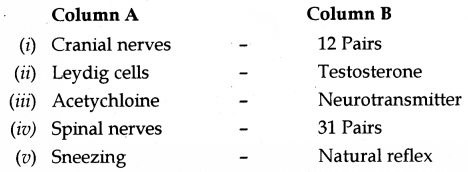
(e) Choose the correct answer from the four options given below : [5]
(i) While recording the pulse rate, where exactly does a doctor press on our wrist?
A. Nerve
B. Vein
C. Artery
D. Capillary
Answer:
C. Artery
(ii) In a human male, a sperm will contain :
A. Both X and Y chromosomes
B. Only Y Chromosomes
C. Only X chromosome
D. Either X or Y Chromosomes
Answer:
A. Both X and Y chromosomes
(iii) A muscular wall is absent in :
A. Capillary
B. Venule
C. Arteriole
D. Vein
Answer:
A. Capillary
(iv) On which day of the menstrual cycle does ovulation take place ?
A. 5th day
B. 28th day
C. 14th day
D. 1st day
Answer:
C. 14th day
(v) Which one of the following does not affect the rate of transpiration ?
A. Light
B. Humidity
C. Wind
D. Age of the plant
Answer:
D. Age of the plant
(f) Identify the ODD term in each set and name the CATEGORY to which the remaining three belong : [5]
Example: glucose, starch, cellulose, calcium, Odd term: calcium.
(i) Addison’s disease, Cushing’s Syndrome, Acromegaly, Leukemia.
(ii) Insulin, Adrenaline, Pepsin, Thyroxine.
(iii) Axon, Dendron, Photon, Cyton.
(iv) Chicken pox, Colour blindness, Haemophilia, Albinism.
(v) Polythene bag, Crop residue, Animal waste, Decaying vegetable.
Answer:

(g) Expand the following biological abbreviations : [5]
(i) ABA
(ii) IAA
(iii) ATP
(iv) DNA
(v) TSH
Answer:
(i) Abscisic acid
(ii) Indole acetic acid
(iii) Adenosine triphosphate
(iv) Deoxyribonucleic acid
(v) Thyroid stimulating hormone
(h) Study the picture given below and answer the following questions: [5]

(i) Identify the type of pollution.
(ii) Name one pollutant that causes the above pollution.
(iii) Mention the impact of this pollution on human health.
(iv) State one measure to control this pollution.
(v) What is a ‘Pollutant’? Explain the term.
Answer:
(i) Water pollution
(ii) Detergents, Chemicals
(iii) Cholera, Jaundice, Typhoid, Dysentery, Diarrhoea
(iv) We should treat the poisonous substances and discharge materials and toxic substances coming out of the homes and factories before discharging them into the rivers and ponds. We should not mix petroleum substances in the water. Dead bodies should not be thrown in the river. We should set more and more sewage treatment plants that play a crucial role in the reclaimed polluted water. Effective steps should be taken to outlaw dumping of wastes into a river or other water sources.
(v) Agents causing pollution are called pollutants.
Example, Gaseous pollutants are so2 , co2 and co.
Chemical pollutants like fertilizers, pesticide and insecticide.
Section – II (40 Marks)
Attempt any four questions from this Section.
Question 2.
Given below is an experimental setup to demonstrate a particular tropic movement in germinating seeds. Study the diagram and answer the questions that follow : [5]

(i) Label the parts 1 and 2.
(ii) Name the tropic movement shown by part 1.
(iii) Part 1 is affected by two stimuli. Name them. Which one of the two is stronger?
(iv) What is Thigmotropism ? Give one example.
(v) What is meant by ‘Positive’ and ‘Negative’ tropic movements in plants?
Answer:
(i) 1 – Radicle 2 – Plumule
(ii) Hydrotropism
(iii) Gravity and Water – Water is stronger.
(iv) Growth movement of plants in response to touch stimulus, e.g., Sweet Pea
(v) Movement of parts of plant towards source of stimulus is positive and away from source of stimulus is negative.
(b) Mention the exact location of the following : [5]
(i) Testis
(ii) Incus
(iii) Thylakoids
(iv) Amniotic fluid
(v) Corpus callosum
Answer:
(i) Inside Scrotum
(ii) Between malleus and stapes.
(iii) In the stroma (matrix) of chloroplast
(iv) Cavity between amnion and embryo
(v) Between two cerebral hemispheres.
Question 3.
(a) The diagram given below represents an experiment to prove the importance of a factor in photosynthesis. Answer the questions that follow : [5]

(i) Name the factor studied in this experiment.
(ii) What will you observe in the experimental leaf after the starch test?
(iii) Explain the process of Photosynthesis.
(iv) Give a balanced chemical equation to represent the process of photosynthesis.
(v) Draw a neat, labelled diagram of an experimental setup to show that oxygen is released during photosynthesis.
Answer :
(i) Sunlight
(ii) The exposed parts will turn blue-black with iodine solution while the part covered with black paper strip turns brown.
(iii) The process by which green plants containing chlorophyll produce food (glucose) from carbon dioxide and water by using light energy.
(iv)

(v)
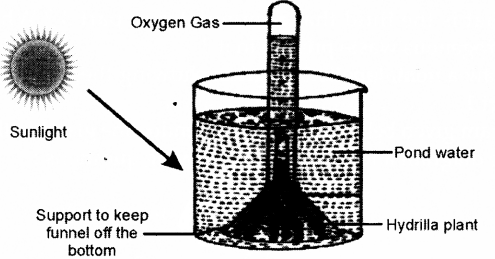
(b) State the main functions of the following : [5]
(i) Medulla Oblongata
(ii) Cytokinins
(iii) Tears
(iv) Coronary Artery
(v) Seminal Vesicles
Answer:
(i) Controls involuntary activities
(ii) Expansion of cotyledons, inhibits apical dominance, cell elongation.
(iii) Helps in killing germs, lubricates surface of eye.
(iv) Supply blood to heart muscles.
(v) Produces secretion which serves as a mediums for transportation of sperms which forms semen.
Question 4.
(a) The diagram given below represents an organ system in the human body. Study the same and answer the questions that follow : [5]

(i) Identify the system.
(ii) Label the parts marked 2 and 4. Mention the function of part 5.
(iii) Name the structural and functional units of the part marked 1.
(iv) What is the fluid that accumulates in part 3? Which is the main nitrogenous waste present in it?
(v) Draw a neat, labelled diagram showing the longitudinal section of part 1.
Answer:
(i) Urinary / Excretory system
(ii) 2 – Left Ureters
4 – Sphincter muscle
5 – Urine is expelled from urinary bladder through urethra.
(iii) Nephron
(iv) Urine; main nitrogenous water present in it is urea.
(v)
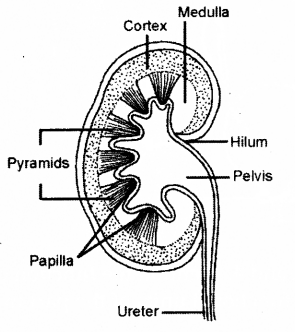
(b) The diagram given below represents an endocrine gland in the human body. Study the diagram and answer the following questions : [5]
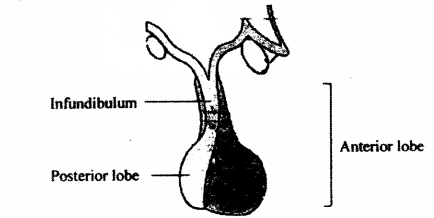
(i) Identify the endocrine gland. Where is it located?
(ii) Why is the above gland referred to as the ‘Master gland’?
(iii) Name the hormone which in deficiency causes Diabetes Insipidus. How does this disorder differ from Diabetes Mellitus ?
(iv) Explain the term ‘Hormone’.
What is the role of Tropic hormones in the human body?
(v) Which lobe of the above gland secretes :
- Oxytocin
- ACTH
- Growth hormone
Answer:
(i) Pituitary gland.
Location – Hangs from the base of midbrain below hypothalamus of brain.
(ii) Because it controls practically all other endocrine gland.
(iii) Antidiuretic hormone ; Its deficiency causes diabetes insipidus (hypoglycemia). Insufficient secretion of insulin causes diabetes mellitus (hyperglycemia). It passes sugar in urine.
(iv) Hormone is the secretion from some glandular part of the body which is poured directly into blood and which acts on target organs or cells of same individual, bringing about coordination between distant parts of the body.
Tropic hormones stimulate other endocrine gland to produce their specific hormone.
(v)
- Posterior lobe
- Anterior lobe
- Anterior lobe
Question 5.
(a) Given below is an apparatus which was set up to investigate a physiological process in plants. The setup was placed in bright sunlight. Answer the questions that follow : [5]
(i) Identify Australopithecus and Neanderthal man from the above pictures.
(ii) Mention two characteristic features each for the two stages.
(iii) Who proposed the theory of ‘Natural Selection’ ?
(iv) Name the organism used as an example to explain ‘Industrial Melanisum’.
(v) Give two examples of Vestigial organs in humans.
Answer:
(i) Transpiration, It is the loss of water in the form of water vapour from aerial exposed parts of plants.
(ii) To prevent escape of water vapour from the pot.
(iii)
- Intensity of sunlight
- Increase in temperature
(iv)
- Sunken stomata
- Thick cuticle
(v)
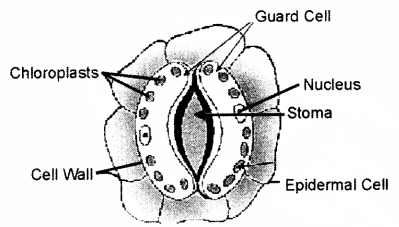
(b) Given below are two stages in the evolution of man. study them and answer the questions that follow: [5]

(i) Identify Australopithecus and Neanderthal man from the above pictures.
(ii) Mention two charcterstic feature each for the two stages.
(iii) Who proposed the theory of ‘Natural Selection’?
(iv) Name the organism used as an example to ‘Industrial Melanisum’.
(v) Give two examples of vestigial organs in humans.
Answer:
(i) A – Neanderthal
B – Australopithecus
(ii) A – Height 600 cm, cranial capacity 1450 cm3
B – Height 120 cm, cranial capacity 450 – 600 cm3
(iii) Charles Darwin
(iv) peppered moth (Biston bitularia)
(v) Vermiform Appendix ; Wisdom tooth
Question 6.
(a) In Mendel’s experiments, tall pea plants (T) are dominant over dwarf pea plants (t). [5]
(i) What is the phenotype and genotype of the F1 generation if a homozygus tall plant is crossed with a homozygus dwarf plant?
(ii) Draw a Punnett square board to show the gametes and offspring when both the parents the heterozygus for tallness.
(iii) What is the Phenotypic ratio and genotypic ratio of the above cross in (ii)?
(iv) State Mendel’s Law of Dominance.
(v) What is a Dihybrid Cross?
Answer:
(i) Phenotype of F1 generation is all are tall plants.
Genotype of F1 generation is all plants are Tf.
(ii) Punett square is as follows :

(iii) Phenotypic ratio = 3:1
Genotypic ratio = 1:2:1
(iv) In a heterozygous condition, out of the two contrasting alleles, one expresses itself morphologically and other remains unexpressed. The factor which expresses itself phenotypically is called dominant and the other which remains unexpressed is called recessive.
(v) A cross between two individuals having two pairs of contrasting traits producing a generation in which all individuals are heterozygous for both the characters.
(b) Given below is a diagram representing a stage during the mitotic cell division. Study the diagram and answer the following questions : [5]
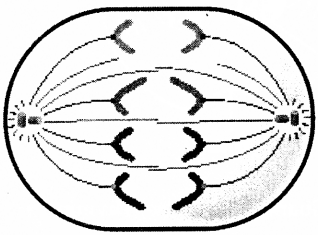
(i) Identify the stage by giving a suitable reason.
(ii) Is it a plant or an animal cell ? Give a reason to support your answer.
(iii) Draw a neat, labelled diagram of the stage which follows the one shown in the diagram.
(iv) How many chromosomes will each daughter cell have after the completion of the above division ?
(v) Name the four nitrogenous bases.
Answer:
(i) Anaphase: Two sister chromatids move towards opposite poles.
(ii) Animal cell: No cell wall; presence of centrioles at opposite poles.
(iii)
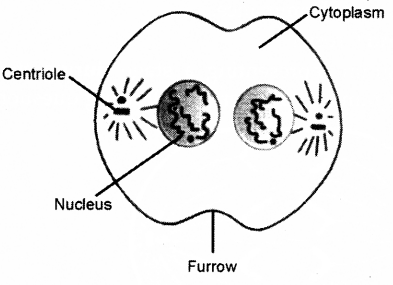
(iv) Four
(v) Adenine, Guanine, Cytosine, Thymine
Question 7.
(a) Answer the following questions briefly : [5]
(i) How are the cytons and axons placed in the brain and the spinal cord ?
(it) Which part of the human ear gives ‘Dynamic balance’ and ‘Static balance’ to the body ?
(in) Explain how the human eye adapts itself to bright light and dim light.
(iv) What is Parthenocarpy ? Give one example.
(v) Mention any two objectives of ‘Swachh Bharat Abhiyan’.
Answer:
(i) In brain, outer portion contains cyton which gives a grayish colour hence called as gray matter, while axon is inside.
In spinal cord, cyton’is inside forming gray matter and axon is outside forming white matter.
(ii) Dynamic balance – semicircular canal
Static balance – utriculus and sacculus (vestibule)
(iii) When a person moves from dark lighted area to brightly lighted area, visual purple of rods is bleached reducing their sensitivity and pupil constricts to reduce the amount of light entering eyes. This is light adaptation.
When a person moves from brightly lighted area to dark area, visual purple of rods which were earlier broken due to bright light regenerates and pupil dilates to allow more light to enter. This is dark adaptation.
(iv) Development of fruit without fertilization, e.g., Apple, banana, tomato.
(v)
- Eliminate open defecation by constructing community toilets.
- Neat and Clean India
(b) The diagram given below represents a system in the human body. Study the diagram and answer the following questions : [5]
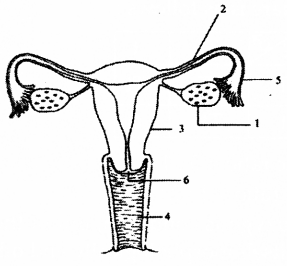
(i) Identify the system.
(ii) Label the parts marked 5 and 6.
(iii) Name the two hormones secreted by 1.
(iv) Mention the number and the name of the part involved in fertilization and implantation from the above diagram.
(v) Mention the surgical methods of contraception in :
- Human males.
- Human females.
Answer:
(i) Human reproductive system
(ii) 5 – Oviducal funnel
6 – Cervix
(iii) Oestrogen, Progesterone
(iv) 2 (Fallopian tube) for fertilization
3 (Uterus) for implantation
(v) 1 – Vasecomy (in males)
2 – Tubectomy (in females)
